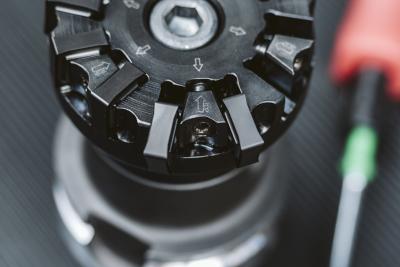
Ceratizit developed its new MaxiMill – S-Power face milling cutters with 12 insert pockets at Ø63 mm and double-sided indexable inserts to handle the tool wear, burr formation, and breakout challenges that the company says are typical in cast iron machining applications.
Plus, the face mill includes an innovative double wedge clamp to ensure the indexable inserts are easy to use and securely attached.
The milling cutters’ double-sided indexable inserts boast eight cutting edges and are made from premium substrates with Dragonskin coating for high performance and smooth cutting action. Robust insert seats together with the double wedge clamps provide secure insert retention along with low axial and radial run-out.
The wedges are fitted with anti-twist protection, and for optimal clamping, there are separate clamping wedges for each holder diameter. Furthermore, the double-sided wedge clamping makes it easy to quickly and accurately change inserts as there is a single screw for each double wedge.
The MaxiMill – S-Power milling cutters are available in standard diameters of Ø56 to Ø125 mm. A setting angle of 88° permits a maximum number of cutting edges, and the indexable inserts are peripherally ground for close tolerances and a high surface quality. The inserts are thicker than conventional inserts, which makes them extremely sturdy.
MaxiMill – S-Power complements existing face milling systems from Ceratizit and is ideal for machining cast iron grades such as ductile cast iron, compacted graphite iron, and gray cast iron. The range of indexable inserts includes ISO P/K with cutting edge geometry M and offers corner radii of 0.4 mm, 0.8 mm and 1.2 mm. The grades include CTPK220, CTCP230 and ceramic.
Contact Details
Related Glossary Terms
- burr
burr
Stringy portions of material formed on workpiece edges during machining. Often sharp. Can be removed with hand files, abrasive wheels or belts, wire wheels, abrasive-fiber brushes, waterjet equipment or other methods.
- compacted graphite iron
compacted graphite iron
Cast iron having a graphite shape intermediate between the flake form typical of gray cast iron and the spherical form of fully spherulitic ductile cast iron. Also known as CG iron, CGI or vermicular iron, it is produced in a manner similar to that of ductile cast iron but using a technique that inhibits the formation of fully spherulitic graphite nodules.
- gang cutting ( milling)
gang cutting ( milling)
Machining with several cutters mounted on a single arbor, generally for simultaneous cutting.
- milling
milling
Machining operation in which metal or other material is removed by applying power to a rotating cutter. In vertical milling, the cutting tool is mounted vertically on the spindle. In horizontal milling, the cutting tool is mounted horizontally, either directly on the spindle or on an arbor. Horizontal milling is further broken down into conventional milling, where the cutter rotates opposite the direction of feed, or “up” into the workpiece; and climb milling, where the cutter rotates in the direction of feed, or “down” into the workpiece. Milling operations include plane or surface milling, endmilling, facemilling, angle milling, form milling and profiling.
- milling machine ( mill)
milling machine ( mill)
Runs endmills and arbor-mounted milling cutters. Features include a head with a spindle that drives the cutters; a column, knee and table that provide motion in the three Cartesian axes; and a base that supports the components and houses the cutting-fluid pump and reservoir. The work is mounted on the table and fed into the rotating cutter or endmill to accomplish the milling steps; vertical milling machines also feed endmills into the work by means of a spindle-mounted quill. Models range from small manual machines to big bed-type and duplex mills. All take one of three basic forms: vertical, horizontal or convertible horizontal/vertical. Vertical machines may be knee-type (the table is mounted on a knee that can be elevated) or bed-type (the table is securely supported and only moves horizontally). In general, horizontal machines are bigger and more powerful, while vertical machines are lighter but more versatile and easier to set up and operate.

